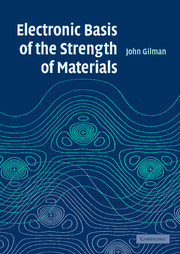Book contents
- Frontmatter
- Contents
- Preface
- Section I Introduction
- Section II Elements of solid mechanics
- Section III Elements of electron mechanics
- Section IV Elastic stiffness
- 9 Cohesion of atoms
- 10 Intramolecular cohesion
- 11 Intermolecular cohesion
- 12 Bulk modulus
- 13 Shear modulus
- 14 Entropic elasticity (polymers)
- 15 Universality and unification
- Section V Plastic strength
- Section VI Fracture resistance
- Index
- References
15 - Universality and unification
Published online by Cambridge University Press: 14 August 2009
- Frontmatter
- Contents
- Preface
- Section I Introduction
- Section II Elements of solid mechanics
- Section III Elements of electron mechanics
- Section IV Elastic stiffness
- 9 Cohesion of atoms
- 10 Intramolecular cohesion
- 11 Intermolecular cohesion
- 12 Bulk modulus
- 13 Shear modulus
- 14 Entropic elasticity (polymers)
- 15 Universality and unification
- Section V Plastic strength
- Section VI Fracture resistance
- Index
- References
Summary
A common theme links chemical, mechanical, and optical hardnesses. It is the gap in the bonding energy spectrum of materials. This gap determines molecular stability, and therefore “chemical hardness” (Pearson, 1997). Chemists call it the LUMO–HOMO gap between anti-bonding and bonding molecular orbitals (LUMO lowest unoccupied molecular orbital, HOMO highest occupied molecular orbital). Physicists call it the band gap between the conduction and valence energy bands (Burdett, 1995). It forms a basis for various properties, including chemical reactivity, elastic stiffnesses, plastic flow resistance (dislocation mobility), crystal structure stability, and optical polarizability (refractive indices). Some of the ways in which this unifying parameter connects chemical, mechanical, and optical properties will be discussed in this chapter.
Another unifying factor is the fact that, for axial bonds between atoms, a simple universal binding energy relationship (called the UBER) exists (Rose, Smith and Ferrante, 1983). Many bonding problems can be reduced to this single relationship which has the form of the “Rydberg function”, f(x) = Ax[exp(- Bx)], and is closely related to the Morse potential. Unfortunately, there is no corresponding universal description for shear deformations.
Partly through coincidence, the name “hardness” which materials engineers have used for centuries to describe mechanical stability was chosen by chemists in recent decades to describe atomic and molecular stability (Pearson, 1997). Happily, the same parameter applies for both chemical and physical properties. It also determines the optical “hardness” of transparent solids.
In solid mechanics, hardness means the resistance to deformation, both elastic and plastic.
- Type
- Chapter
- Information
- Electronic Basis of the Strength of Materials , pp. 179 - 184Publisher: Cambridge University PressPrint publication year: 2003



